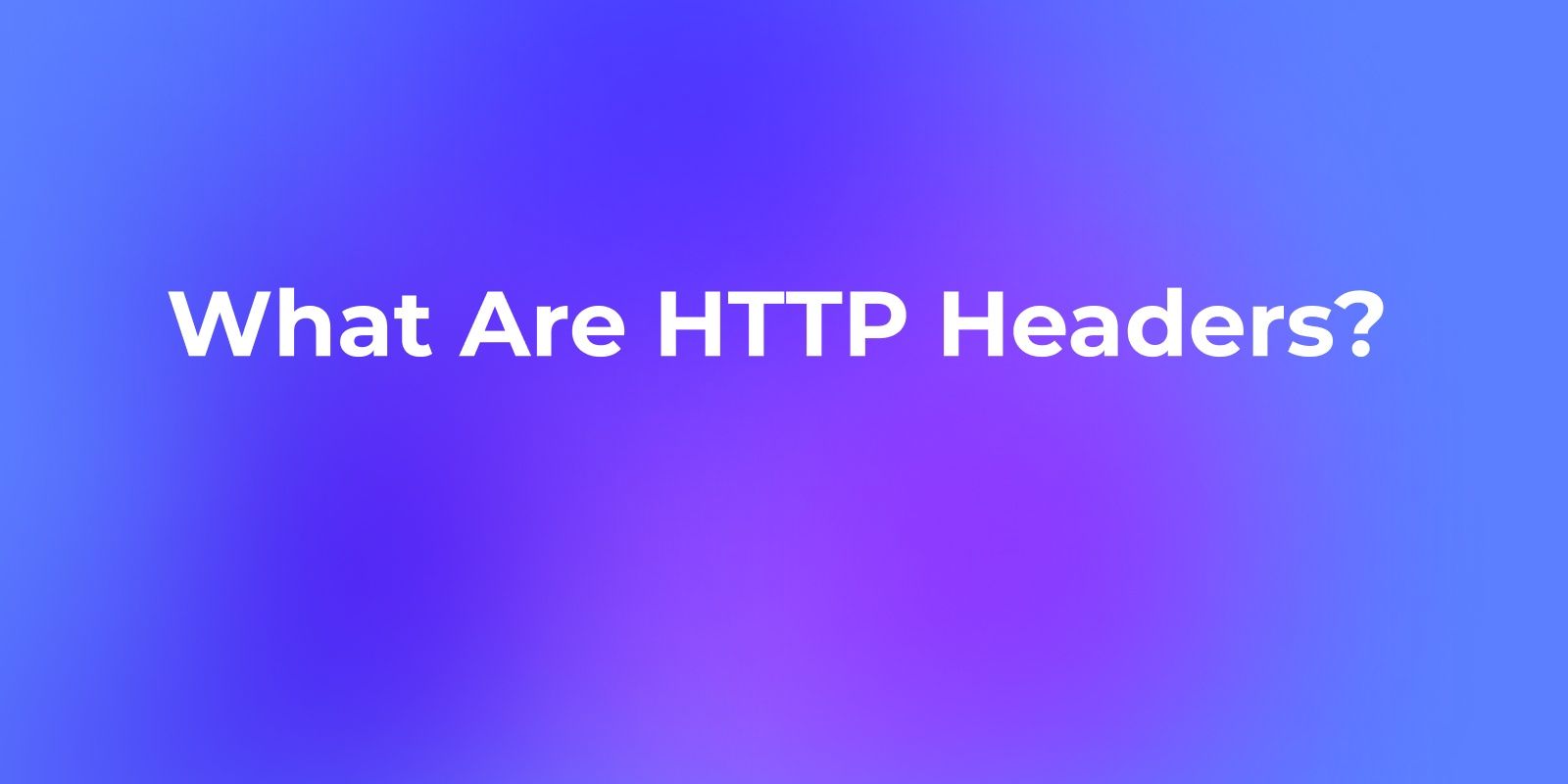When it comes to web development, there's a lot happening behind the scenes that can affect your website's performance, security, and functionality. One essential aspect of this is HTTP headers. These seemingly small bits of data play a crucial role in how information is exchanged between your web browser and a web server. In this comprehensive guide, we'll delve deep into HTTP headers, what they are, how they work, and why they matter.
What are HTTP Headers?
HTTP headers are the unsung heroes of the World Wide Web. They are essential components of the HTTP protocol, which governs how data is transmitted between a web browser (client) and a web server. In simple terms, HTTP headers are metadata that accompany every HTTP request and response, providing crucial information about the data being sent or received.
These headers are structured as key-value pairs, with each header field separated from its value by a colon. They are separated from the message body (the actual content) by an empty line, making them distinct from the page's visible content. While the average internet user may never see HTTP headers, they play a fundamental role in making the web work efficiently and securely.
Types of HTTP Headers
HTTP headers come in various flavors, each serving a specific purpose. Let's take a closer look at some of the most common types:
General Headers:
General headers are an integral part of both HTTP request and response messages, but they do not directly pertain to the data contained within the message body. These headers serve to convey fundamental information about the message's overall handling and transmission. Some examples of general headers include:
- Connection: The "Connection" header specifies whether the connection should be kept alive for multiple requests and responses or closed after a single exchange. It can have values like "keep-alive" or "close."
- Date: The "Date" header indicates the timestamp when the message was generated. This timestamp is valuable for understanding the temporal aspects of the HTTP transaction.
Request Headers:
Request headers are a subset of HTTP headers that accompany client-initiated requests to a server. They provide supplementary information about the client's request, aiding the server in processing and responding appropriately. A few notable request headers include:
- User-Agent: The "User-Agent" header provides information about the client application or user agent making the request. This helps the server tailor its response to match the capabilities and preferences of the client, such as the type of browser or device being used.
Response Headers:
Response headers are specific to HTTP responses sent by the server to the client. They furnish vital information about the server's response, ensuring the client can interpret and handle it correctly. An example of a response header is:
- Server: The "Server" header informs the client about the software or platform being utilized on the server side. This header can reveal details about the web server software in use.
Entity Headers:
Entity headers focus on providing details about the content encapsulated within the message body. These headers are crucial for understanding and correctly processing the data within the HTTP message. Two prominent entity headers are:
- Content-Type: The "Content-Type" header specifies the media type or format of the data in the message body. It ensures that both the client and server know how to interpret and display the content, whether it's HTML, JSON, XML, or another format.
- Content-Length: The "Content-Length" header conveys the size of the message body in octets (bytes). This information is essential for accurately reading and processing the content, preventing data truncation or overconsumption.
Authentication Headers
Headers like "Authorization" and "WWW-Authenticate" are crucial for secure communication, allowing clients and servers to exchange authentication data.
Caching Headers
Headers like "Cache-Control" and "Expires" help browsers determine whether to retrieve a resource from the cache or request it from the server.
CORS Headers
Cross-Origin Resource Sharing (CORS) headers, including "Access-Control-Allow-Origin" and "Access-Control-Allow-Methods," control which domains can access resources on a web page.
Security Headers
Security headers like "Content-Security-Policy" and "Strict-Transport-Security" enhance web application security by enforcing certain policies.
There are many more headers with specialized functions, such as "Location" for redirects, "Referer" for tracking referrals, and "Expect" for defining server expectations.
How to Work with HTTP Headers in Apidog
Working with HTTP headers using Apidog is a straightforward process. Apidog is an API documentation and testing tool that helps developers manage and document their APIs. Here's a step-by-step guide on how to work with HTTP headers using Apidog:
Step 1: Access Apidog
If you haven't already, access Apidog by visiting Apidog online or downloading it onto a desktop. Sign in to your Apidog account or create one if needed.
Step 2: Create or Open a Project
In Apidog, you organize your API documentation and requests within projects. You can either create a new project or open an existing one that contains the API request you want to work with.

Step 3: Create or Open an API Request
Within your project, create a new API request or open an existing one. If you're creating a new request, make sure to specify the request method (e.g., GET, POST, PUT, DELETE) and the request URL.

Step 4: Set HTTP Headers in Detail
To work with HTTP headers in Apidog, click on the "Headers" section to open it.

- You'll typically see a list of headers with fields for "Name" and "Value." Here, you can add, bulk edit, or remove headers as needed.
- To add a new header, click on the "Add Header" button or a similar option. You'll then be prompted to enter the name and value of the header. For example, if you want to set the "Authorization" header, enter "Authorization" as the name and your authentication token as the value.
- To edit an existing header, simply click on it, and you can modify the name or value.
- To remove a header, click on the "Delete" icon next to the header you want to delete.
Step 5: Save and Test the Request
After setting the HTTP headers according to your requirements, be sure to save the API request.
You can now test the API request by clicking a "Send" button within Apidog. This will send the request to the specified API endpoint with the headers you've configured.

Step 6: View Response Headers
Apidog typically provides a section where you can view the response headers received from the server after sending the request. This section is often labeled "Response."
By utilizing tools like Apidog and following best practices, developers can work efficiently with HTTP headers, ensuring their websites and web applications perform optimally and securely.
Best Practices for Using HTTP Headers
Now that we've explored the different types of HTTP headers let's delve into some best practices for using them effectively:
Keep Headers Concise: Avoid including unnecessary information in headers, as larger headers can impact performance. Remove redundant headers to reduce the risk of exposing sensitive data accidentally.
Leverage Caching Headers: Implement caching headers like "Cache-Control" to reduce server load and improve page load times. Caching allows browsers to store and reuse resources, reducing the need for repeated requests.
Prioritize Security: Never include sensitive data, such as passwords or API keys, in plain text headers. Implement logic to validate and sanitize request headers to prevent security vulnerabilities like header injection attacks.
Handle CORS Safely: When working with Cross-Origin Resource Sharing, configure CORS headers carefully to prevent unauthorized access to your resources. Specify allowed origins, methods, and headers to enhance security.
Content Negotiation: Use request headers like "Accept" to indicate the preferred content type, allowing the server to provide responses in the format the client can understand.
Content Compression: Employ response headers like "Content-Encoding" to enable content compression, reducing data transfer and improving page load times for users.
Authentication: Ensure that authentication headers like "Authorization" are used securely, following best practices for token-based authentication or other methods.
Error Handling: Implement appropriate response headers, such as "WWW-Authenticate" when dealing with authentication errors, to guide clients on how to proceed.
By adhering to these best practices, web developers can ensure that their HTTP headers contribute to a secure, efficient, and user-friendly web experience.
Conclusion
HTTP headers may operate behind the scenes, but they are the unsung heroes of web development. These small bits of metadata play a vital role in ensuring secure, efficient, and user-friendly interactions between clients and servers. By understanding the various types of headers, adhering to best practices, and utilizing tools like Apidog, developers can harness the power of HTTP headers to optimize their websites and provide a seamless user experience.
As you continue your journey in web development, remember that HTTP headers are your allies in delivering content faster, enhancing security, and enabling advanced features. Keep exploring, experimenting, and fine-tuning your use of HTTP headers to make the most of this essential component



